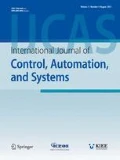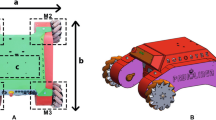Abstract
This study presents an effective orientation compensation scheme for four-wheel vehicles with misaligned caster wheels in order to correct unexpected driving errors due to an unbalanced load or power. By accumulating angular differentials from the desired heading until achieving steady state driving, we obtain the net rotation angle and then compensate for it by controlling the speed difference of the two driving wheels on left and right sides. It is shown through experiments with an electricpowered wheelchair that the proposed orientation compensation scheme prevents transient swerve due to misaligned caster wheels and thus enables the vehicle to follow its expected driving path.
Similar content being viewed by others
References
H. Wang, B. Salatin, G. Grindle, D. Ding, and R. Cooper, “Real-time model based electrical powered wheelchair control,” Medical Engineering & Physics, vol. 31, no. 10, pp. 1244–1254, 2009.
Y. Hirata, A. Hara, and K. Kosuge, “Motion control of passive intelligent walker using servo brakes,” IEEE Trans. on Robotics, vol. 23, no. 5, pp. 981–990, 2007.
B. W. Johnson and J. H. Aylor, “Dynamics modeling of an electric wheelchair,” IEEE Trans. on Industry Applications, vol. 21, no. 5, pp. 1284–1293, 1985.
J. H. Chung, B.-J. Yi, W. K. Kim, and S.-Y. Han, “Singularity-free dynamic modelling including wheel dynamics for an omni-directional mobile robot with three caster wheels,” International Journal of Control, Automation, and Systems, vol. 6, no. 1, pp. 86–100, 2008.
S. Kim and B. Moon, “Complete identification of isotropic configuration of a caster wheeled mobile robot with nonredundant/redundant actuation,” International Journal of Control, Automation, and Systems, vol. 4, no. 4, pp. 486–494, 2006.
F. Chenier, P. Bigras, and R. Aissaoui, “An orientation estimator for the wheelchair’s caster wheels,” IEEE Trans. on Control Systems Technology, vol. 19, no. 6, pp. 1317–1326, 2011.
D. Ding, R. A. Cooper, S. Guo, and T. A. Corfman, “Analysis of driving backward in an electricpowered wheelchair,” IEEE Trans. on Control Systems Technology, vol. 12, no. 6, pp. 934–943, 2004.
Author information
Authors and Affiliations
Corresponding author
Additional information
Recommended by Editorial Board member Sooyeong Yi under the direction of Editor Hyouk Ryeol Choi.
This research was supported by the Ministry of Trade, Industry, and Energy, Korea, under the Industrial Convergence Technology Development Program(ID:10040132) and by Basic Research Program through the National Research Foundation of Korea (NRF) funded by the Ministry of Education, Korea (ID: 2010-0024835).
Doo-Am Lee received his B.S. degree in Electronic Engineering from Mokpo National Maritime University, and his M.S. degree in Electrical Engineering from Konkuk University. He is currently working toward a Ph.D. in Konkuk University. His current research interests include teleoperation control systems and electric vehicles.
Dong-Geun Jeong received his B.S. degree in Electronic and Electrical Engineering from KAIST (KOREA Advanced Institute of Science and Technology) in 1990, and his M.S. degree in Electrical Engineering from Konkuk University in 2012. He is currently working toward the Ph.D. in Konkuk University. His research interests are in the areas of control engineering for plant systems, wireless communication, and system integration.
Kwang-Sik Woo received his B.S. degree in Electronic Engineering form Mokpo National Maritime University in 2012. He is currently working toward the M.S. degree in Konkuk University. His current research interests include teleoperation control systems and electric vehicles.
Lark-Kyo Kim received his B.S. degree in Electrical Engineering from Hanyang University, and his M.S. and Ph.D. degrees in Electrical Engineering from Yonsei University in 1977 and 1985, respectively. He was a visiting scholar at the Ohio State University in 1996–97, at the University of Adelaide in 2009–2010. During 1978–80, he was a senior researcher at Korea Atomic Energy Research Institute. He has been a professor in the Dept. of Electrical Eng. of Konkuk University since 1980. His research interests are in the areas of an adaptive, neuro-fuzzy, and artificial intelligence controls, and their applications.
Hyungsoo Mok received his B.S., M.S. and Ph.D. degrees in Electrical Engineering from Seoul National University, Korea, in 1986, 1988, and 1992, respectively. He was with the Department of Control and Instrumentation Engineering at Seoul National Polytechnic University from 1993 to 1997. Since 1997, he has been with the Department of Electrical Engineering at Konkuk University. His teaching and research interests include electric machines, electric machine drive systems, and power electronic control for industrial and power systems.
Soohee Han received his B.S. degree in Electrical Engineering from Seoul National University (SNU), Seoul, Korea in 1998. He received his M.S. and Ph.D. degrees in School of Electrical Engineering and Computer Science from SNU in 2000 and 2003, respectively. From 2003 to 2007, he was a researcher at the Engineering Research Center for Advanced Control and Instrumentation of SNU. In 2008, he was a senior researcher at the robot S/W research center. Since 2009, he has been with the Department of Electrical Engineering, Konkuk University, Seoul, Korea. His main research interests are in the areas of computer aided control system design, distributed control system, time delay system, and stochastic signal processing. He is currently an Associated Editor of International Journal of Control, Automation, and Systems, and Journal of Electrical Engineering & Technology. In 2012, he was a Guest Editor of Mathematical Problems in Engineering for optimal control problems in engineering. He served as the financial chair of IFAC and ICCAS for 2008 and 2012, respectively.
Rights and permissions
About this article
Cite this article
Lee, DA., Jung, DG., Woo, KS. et al. Orientation compensation for initially misaligned caster wheels. Int. J. Control Autom. Syst. 11, 1071–1074 (2013). https://doi.org/10.1007/s12555-012-9112-6
Received:
Revised:
Accepted:
Published:
Issue Date:
DOI: https://doi.org/10.1007/s12555-012-9112-6




